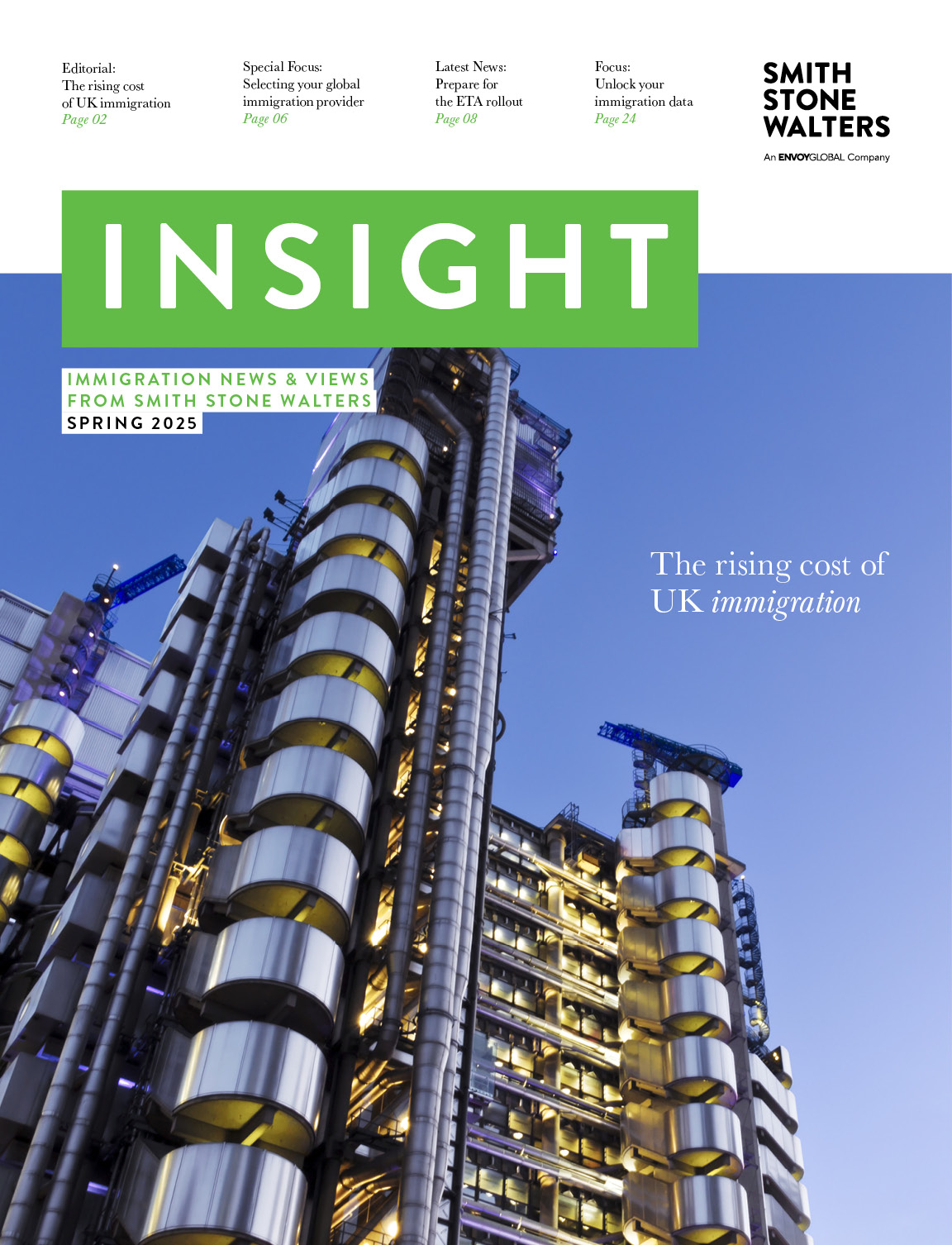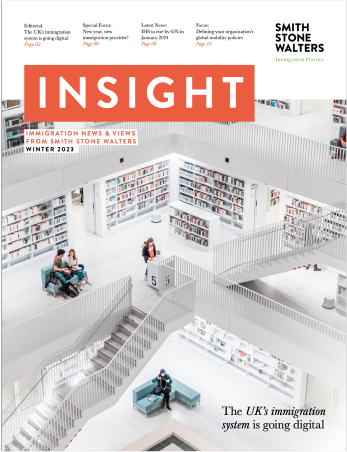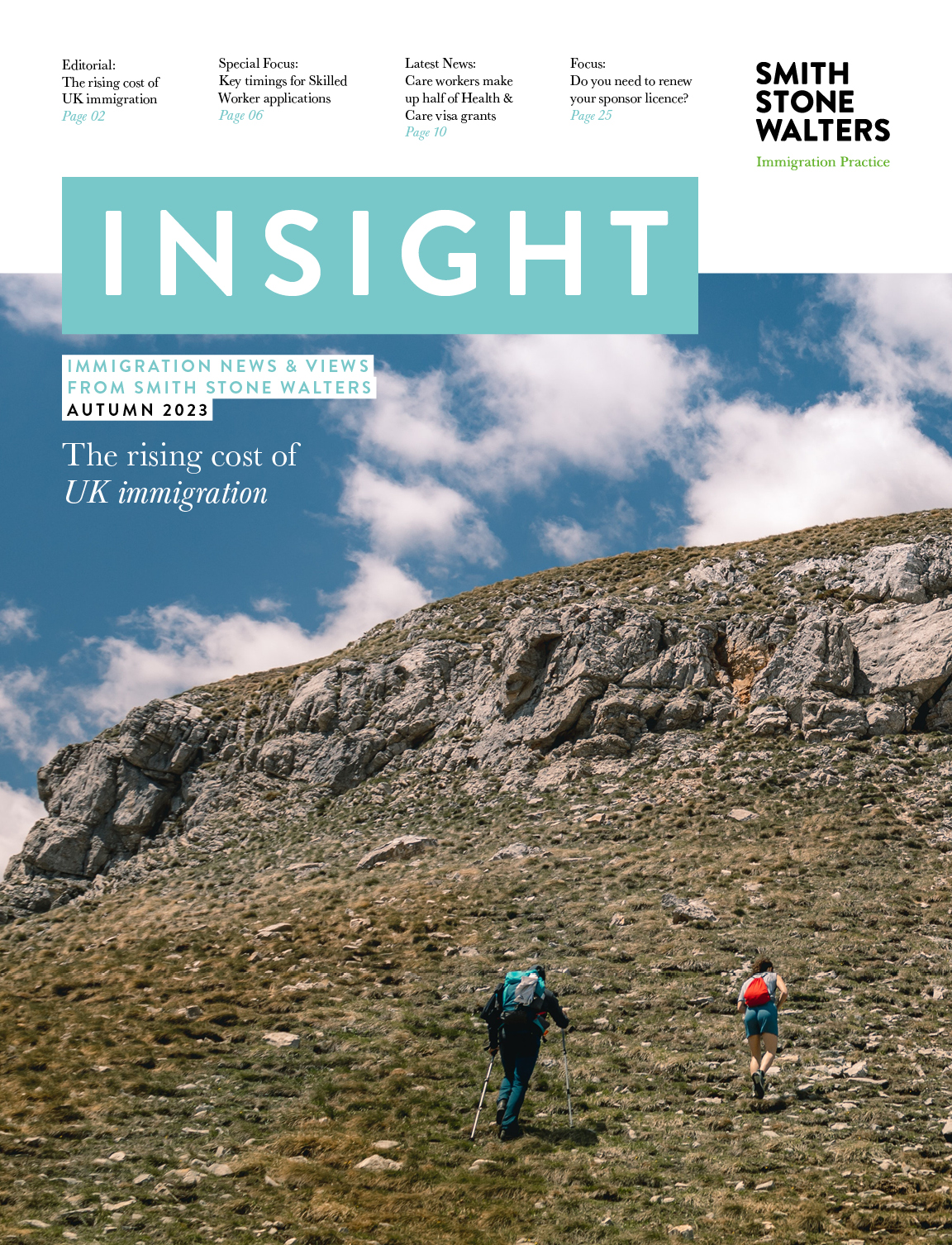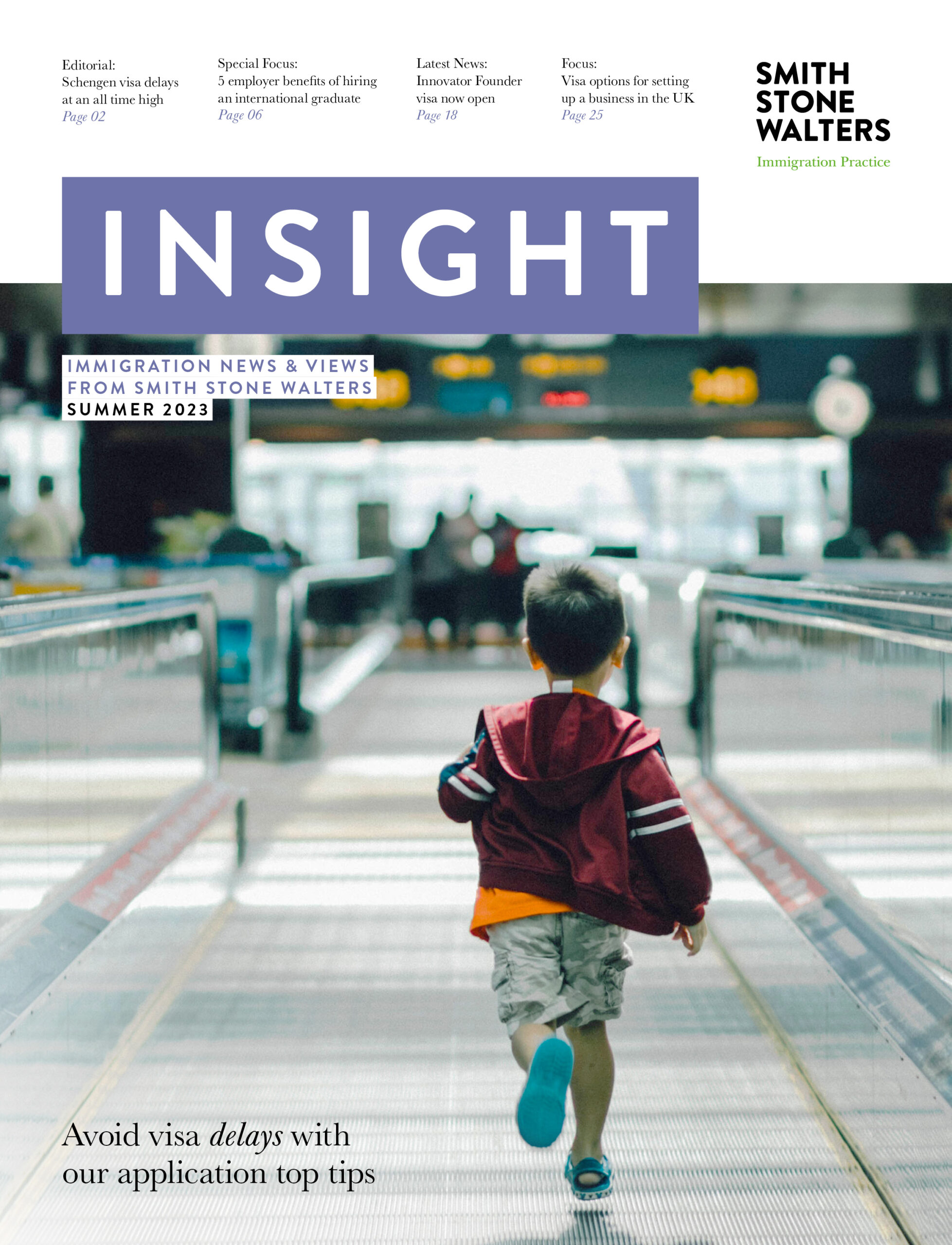Latest updates in global immigration
This week, the Global Immigration team at Smith Stone Walters would like to highlight the following recent updates from Canada, Ireland, New Zealand and the United States.
Canada: Permanent residence fees increase
The Canadian government has given notice that fees for permanent residence will increase on 30 April 2024.
The increase is in line with the cumulative percentage increase in the consumer price index published by Statistics Canada, for the two previous years, rounded to the nearest five dollars. Since 2020, Canada has increased immigration fees every two years.
The increases are as follows:
- The Right of Permanent Residence fee will increase from CAD 515 to CAD 575;
- The fees for Federal Skilled Workers, the Provincial Nominee Program, Quebec Skilled Workers, Atlantic Immigration Class and most economic pilots will increase from CAD 850 to CAD 950;
- The Live-in Caregiver Program and caregivers pilots fee will increase from CAD 570 to CAD 635;
- The fee for the Business category (federal and Quebec) will increase from CAD 1625 to CAD 1810;
- The Family reunification fee will increase from CAD 490 to CAD 545;
- The fees for protected persons, humanitarian and compassionate consideration and public policy will increase from CAD 570 to CAD 635;
- The permit holders fee will increase from CAD 335 to CAD 375;
- Fees will also increase for accompanying spouses and common-law partners as well as for dependent children.
Ireland: Update of eligibility requirements for stamp 4 upgrades
On 15 November 2023, Immigration Service Delivery (ISD) placed a web notice regarding the cessation of the provision of Stamp 4 support letters by the Department of Enterprise, Trade, and Employment (DETE), effective 30 November 2023.
Eligibility for a Stamp 4 upgrade has been under review by ISD since the effective date of this change to the application process. This review has since concluded with the below-listed change to eligibility now effective:
Employees residing in Ireland on a Stamp 1 or 1H permission are eligible for a Stamp 4 upgrade upon completion of 21 months from commencement of employment in Ireland, on the basis of:
(i) a Critical Skills Employment Permit
(ii) a Hosting Agreement as a Researcher
(iii) a Multi-Site General Employment Permit as a Non-Consultant Hospital Doctor.
Alternatively, eligibility depends on completion of 57 months from commencement of employment in Ireland on the basis of:
(iv) General Employment Permits
(v) Intra-Company Transfer Permits
Please Note:
- In determining eligibility, categories (iv) and (v) are not interchangeable with (i), (ii), and/or (iii).
- The documents required at registration have not changed.
- Commencement of employment in Ireland will be determined via an ‘Employment Detail Summary’, available on revenue.ie/myaccount.
New Zealand: New immigration law infringement penalties
Effective 11 April 2024, Immigration New Zealand (INZ) will be able to issue infringement notices to employers with the aim of addressing lower-level immigration non-compliance and deter those who take advantage of migrant workers.
Infringements can be issued for employing people in breach of their visa conditions, employing a person unlawfully in New Zealand, or failing to comply with a 10-day information request.
Infringement penalties can include: a minimum fine of NZD 1000, loss of Accredited Employer or Recognised Seasonal Employer status, and being banned (stood-down) from supporting further visas for migrant workers for a period of time depending on the number of infringement notices the employer receives. More serious breaches may result in criminal charges.
Being stood-down means employers cannot get their accreditation back or support visa applications during the stand-down period. Stand-down periods include: 6-month stand-down for a single infringement notice, an extra 6-month stand-down for each subsequent infringement notice and a 12-month maximum stand-down for multiple notices issued at one time.
Employers can hire migrants on open work visas while on the stand-down list. When the stand-down ends the employer must show they have rectified the matter and done what is needed to stop it happening again before they can get accredited again under the Accredited Employer Work Visa (AEWV).
INZ will be publishing a stand down list on the Immigration website naming those employers who have been penalised and stood down.
New Zealand: New pathway for secondary school teachers
From May 2024, secondary school teachers move to the Straight to Residence pathway on the Green List of in-demand roles.
This move helps fill the likely shortage of secondary school teachers in the short to medium term.
The change allows eligible overseas secondary school teachers to apply for residence from outside New Zealand:
- when they have an offer of employment with an accredited employer, and
- without needing to work for 2 years in New Zealand first.
Other teachers remain on the Work to Residence pathway.
United States: New guidance on Form I-693 validity period
On 4 April 2024, US Citizenship and Immigration Services (USCIS) announced that any Form I-693, Report of Immigration Medical Examination and Vaccination Record, that was properly completed and signed by a civil surgeon on or after 1 November 2023, does not expire and can be used indefinitely as evidence to show that the applicant is not inadmissible on health-related grounds.
In consultation with the Centres for Disease Control and Prevention (CDC), and based on advances in public health electronic notification, USCIS has determined that a Form I-693’s evidentiary value should no longer be limited to a certain period if it is properly completed and was signed by a civil surgeon on or after 1 November 2023. USCIS officers have discretion to request more evidence or a new or updated Form I-693 if they have reason to believe the applicant’s medical condition has changed since the civil surgeon signed the Form I-693, or that the Form I-693 submitted does not accurately reflect the applicant’s medical condition and the applicant may be inadmissible on health-related grounds.
If an applicant’s immigration medical examinations were completed before 1 November 2023, the prior policy still applies. Before 1 November 2023, civil surgeons did not need to share or report certain information to the CDC electronically. USCIS has consulted with the CDC and determined that a properly completed Form I-693 signed by a civil surgeon before 1 November 2023, continues to retain evidentiary value for two years from the date of the civil surgeon’s signature. This does not apply to Forms I-693 filed by Operation Allies Welcome parolees. Their Forms I-693 retain their evidentiary value for three years from the date of the civil surgeon signature, through policy and in consultation with CDC.
United States: Increased automatic extension of certain employment authorisation documents
On 4 April 2024, US Citizenship and Immigration Services (USCIS) announced a temporary final rule (TFR) to increase the automatic extension period for certain employment authorization documents (EADs) from up to 180 days to up to 540 days.
The temporary measure announced today will prevent already work-authorized noncitizens from having their employment authorization and documentation lapse while waiting for USCIS to adjudicate their pending EAD renewal applications and better ensure continuity of operations for U.S. employers.
This TFR aligns with an ongoing effort at USCIS to support employment authorized individuals’ access to work. USCIS has reduced EAD processing times overall and streamlined adjudication processing, including:
- Reducing by half EAD processing times of individuals with pending green card applications from FY2021 to date,
- Processing a record number of EAD applications in the past year, outpacing prior years,
- Engaging with communities to educate work-eligible individuals who were not accessing the process and provide on-the-ground intake support of applications,
- Reducing processing time for EADs for asylum applicants and certain parolees to less than or equal to 30-day median,
- Extending EAD validity period for certain categories from 2 years to 5 years,
- Streamlining the process for refugee EADs, and
- Expanding online filing for EADs to asylum applications and parolees.
This temporary measure will apply to eligible applicants who timely and properly filed an EAD renewal application on or after 27 October 2023, if the application is still pending on the date of publication in the Federal Register. The temporary final rule will also apply to eligible EAD renewal applicants who timely and properly file their Form I-765 application during a 540-day period that begins with the rule’s publication in the Federal Register.
Absent this measure, nearly 800,000 EAD renewal applicants – including those eligible for employment authorization as asylees or asylum applicants, Temporary Protected Status (TPS) applicants or recipients, and green card applicants – would be in danger of experiencing a lapse in their employment authorization, and approximately 60,000 to 80,000 employers would be negatively impacted as a result of such a lapse. EADs are generally valid for the length of the authorized parole period. This TFR does not extend the length of parole.
As part of this temporary final rule, USCIS is soliciting feedback from the public that would inform potential future regulatory action. For more information, visit our Automatic Employment Authorization Document Extension page.
United States: USCIS Provides Third Gender Option on Form N-400
United States Citizenship and Immigration (USCIS) has revised Form N-400, Application for Naturalization, to provide a third gender option, “X,” defined as “Another Gender Identity.” USCIS is also updating guidance in the USCIS Policy Manual accordingly to account for this form revision and other forthcoming form revisions that will add a third gender option.
The 04/01/24 edition of Form N-400 will be the first USCIS form to include the X gender option. Applicants filing this edition of Form N-400 on or after 1 April 2024, will have X immediately available as a gender option on their form.
Applicants who have a pending Form N-400 using the edition in effect before 1 April 2024, may request to update their gender on or after 1 April 2024, as well. For all other forms, individuals must wait until USCIS revises those forms to include the X gender option.
Form N-400 is the only USCIS form that offers the X gender option at this time. Therefore, until the completion of additional form revisions that add the X gender option, naturalization certificates are the only USCIS-issued secure identity documents that can reflect the gender X. The X gender option is not yet available on the Form N-565.
Those who have other benefit requests pending with USCIS and would like to choose X as their gender, or who would like to change their existing USCIS-issued secure identity documents to reflect X as their gender, must wait until USCIS updates the relevant forms. Once USCIS updates additional forms to offer the X gender option, benefit requestors may follow the instructions on the Updating or Correcting Your Documents webpage to select the X gender option.
Supporting Documentation Not Needed:
Applicants do not need to provide supporting documentation to select X as their gender initially or to change their gender selection for Form N-400. The gender selected does not need to match the gender listed on their other immigration documents or on supporting identity documents, such as their birth certificate, passport, or state identification.
Social Security Card:
Note that if the X gender option is selected on the new Form N-400, users may need to visit a Social Security office for a Social Security card or to update their citizenship status. The Social Security Administration is still developing systems to accept the X gender option.
Background:
Historically, USCIS forms and associated documents have only offered two gender options: “Male (M)” and “Female (F).” This has created significant barriers for requestors who do not identify with either of those options. Limiting benefit requestors to two gender options also creates administrative challenges for USCIS when receiving birth certificates or other official government-issued documents with a gender other than M or F. Adding a third gender option helps ensure that secure identity documents and biographical data are accurate and helps both external stakeholders and individuals requesting immigration benefits. It is also consistent with federal and state agencies that have adopted a third gender option, such as the US Department of State’s expanded passport services to offer gender X in their application.
In March 2023, USCIS updated the Policy Manual to allow for the self-selection of gender on USCIS forms. (PDF, 333.48 KB) This policy update allows benefit requestors to select their gender on all USCIS forms without providing supporting documentation (except for Form N-565, which requires a formal form revision to implement this policy). Benefit requestors may also change a prior selection without the need to provide specific supporting documentation, or to match prior documentation provided. This revision is consistent with efforts to break down barriers in the immigration system and reduce undue burdens in accessing immigration benefits, while still maintaining identity verification and fraud prevention procedures.
United States: Filing location change for certain employment-based I-485 and related forms
On 1 April 2024, US Citizenship and Immigration Services (USCIS) is changing the filing location for concurrently filed Forms I-907, Request for Premium Processing Service; I-140, Immigrant Petition for Alien Worker; and I-485, Application to Register Permanent Residence or Adjust Status, and for related Forms I-131, Application for Travel Document; I-765, Application for Employment Authorization; and I-824, Application for Action on an Approved Application or Petition, filed with the application package, from USCIS service centres to a USCIS lockbox.
The addresses to use when mailing concurrently filed Forms I-907, I-140, and I-485, and for any related Forms I-131, I-765, and I-824 filed with the application package. Starting May 2, 2024, we may reject concurrently filed Forms I-907, I-140, and I-485, and any related Forms I-131, I-765, and I-824 filed with the application package, that are received at the USCIS service centres are listed here.
Applicants, petitioners and requestors are advised to file online when possible.
Expert advice on global immigration
If you need support with any aspect of global immigration, Smith Stone Walters is here to help.
To speak to a member of our global immigration team, please contact us today.










